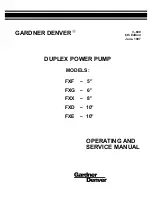
English
8
nOTE:
Battery packs should not be stored completely
depleted of charge. The battery pack will need to be
recharged before use.
SAVE THESE INSTRUCTIONS FOR
FUTURE USE
Motor
Be sure your power supply agrees with the nameplate
marking. Voltage decrease of more than 10% will cause loss
of power and overheating.
D
e
WALT
tools are factory tested;
if this tool does not operate, check power supply.
COMPONENTS (FIG. A)
WARNING:
Never modify the power tool or any part
of it. Damage or personal injury could result.
Refer to Figure A at the beginning of this manual for a
complete list of components.
Intended Use
This impact wrench is designed for professional impact
fastening and drilling applications. The impact function
makes this tool particularly useful for driving fasteners in
wood, metal and concrete.
DO nOT
use under wet conditions or in presence of
flammable liquids or gases.
DO nOT
let children come into contact with the tool.
Supervision is required when inexperienced operators use
this tool.
OPERATION
WARNING: To reduce the risk of serious personal
injury, turn unit off and disconnect it from
power source remove the battery pack before
making any adjustments or removing/installing
attachments or accessories.
An accidental start-up
can cause injury.
Installing and Removing the Battery Pack
(Fig. D)
nOTE:
For best results, make sure your battery pack is
fully charged.
To install the battery pack
6
into the tool handle, align the
battery pack with the rails inside the tool’s handle and slide
it into the handle until the battery pack is firmly seated in
the tool and ensure that it does not disengage.
To remove the battery pack from the tool, press the release
button
5
and firmly pull the battery pack out of the tool
handle. Insert it into the charger as described in the charger
section of this manual.
Fig. D
5
6
Proper Hand Position (Fig. E)
WARNING:
To reduce the risk of serious personal injury,
ALWAYS
use proper hand position as shown.
WARNING:
To reduce the risk of serious personal injury,
ALWAYS
hold securely in anticipation of a sudden
reaction.
Proper hand position requires one hand on the main
handle
4
.
Fig. E
4
Variable Speed Trigger Switch (Fig. A)
To turn the tool on, squeeze the trigger switch
1
. To turn
the tool off, release the trigger switch. Your tool is equipped
with a brake. The anvil will stop when the trigger switch
is fully released. The variable speed switch enables you to
select the best speed for a particular application. The more
you squeeze the trigger, the faster the tool will operate. For
maximum tool life, use variable speed only for starting holes
or fasteners.
nOTE:
Continuous use in variable speed range is not
recommended. It may damage the switch and should
be avoided.
Forward/Reverse Control Button (Fig. A)
A forward/reverse control button
2
determines the
direction of the tool and also serves as a lock-off button.
To select forward rotation, release the trigger switch and
depress the forward/reverse control button on the right side
of the tool.
To select reverse, release the trigger switch and depress the
forward/reverse control button on the left side of the tool.





























